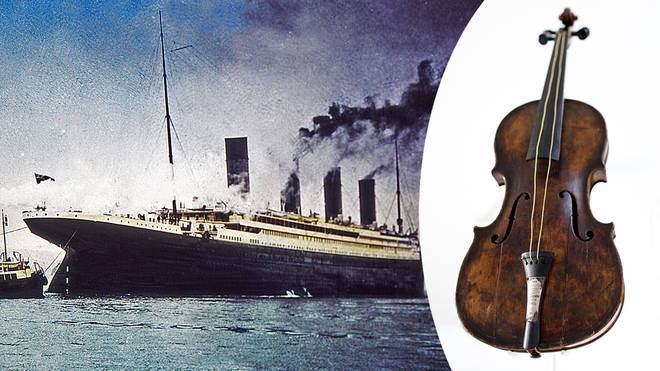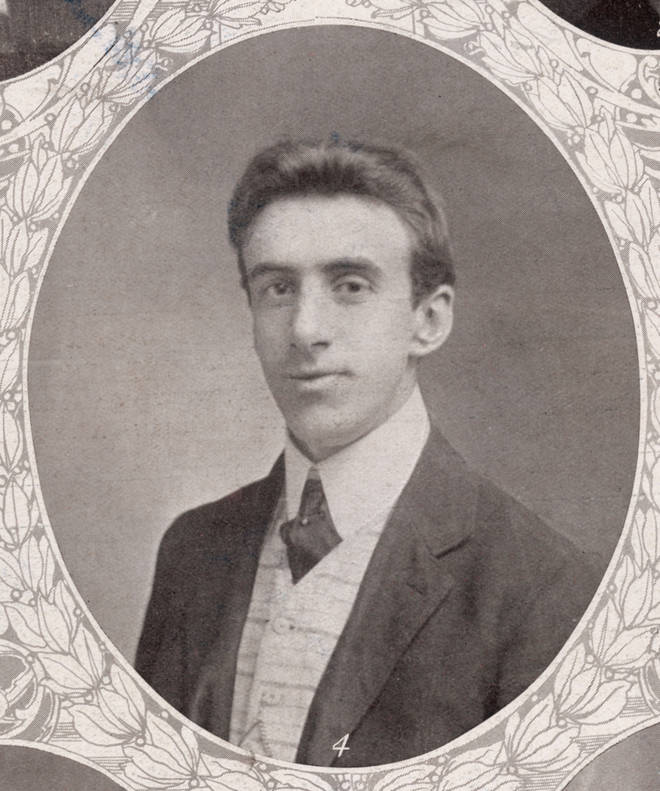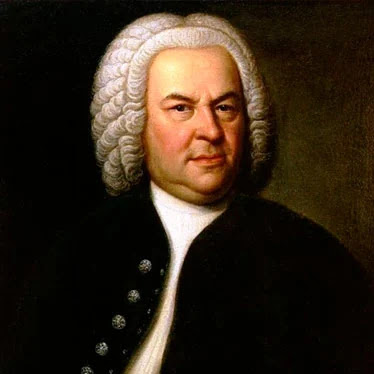It's all about the classical music composers and their works from the last 400 years and much more about music. Hier erfahren Sie alles über die klassischen Komponisten und ihre Meisterwerke der letzten vierhundert Jahre und vieles mehr über Klassische Musik.
Total Pageviews
Wednesday, August 17, 2022
Davao City composer explains what is popular Kadayawan song ‘Bahaghari Tayo’ all about
LANDERO (Keith Bacongco)
by Keith Bacongco, Manila Bulletin
DAVAO CITY – For almost 20 years, the iconic song “Bahaghari Tayo” composed by local music legend Popong Landero is always associated with the annual Kadayawan Festival every August.
Aside from Davaoeños, this festive song is also familiar among those who are frequent visitors of this city not just during the Kadayawan Festival but also the Araw ng Davao celebration.
The song is usually played in public places during festivities.
But what is really the inspiration behind the making of this festive song?
Unknown to many, Bahaghari Tayo does not simply depict festivity but it is more about the recovery from fear, pain, and suffering from terrorist attacks in this city, Landero admitted to the Manila Bulletin.
“When I heard that a bomb exploded at the airport, I was very worried because my wife was working there. Although she was safe because they were inside,” he recalled, referring to the bomb attack on March 4, 2003 that killed 21 people and injured hundreds here.
The incident, the musician added, reminded him of a grenade blast during college days at the University of Mindanao in the 1980s that injured several people. “The explosion was quite close to the spot where we were playing guitar. We saw some people injured and the debris even hit our heads. We were shocked and a lot of people panicked.”
Based on this experience, Landero added, he tried making a song but it never materialized. “So I just tried to forget that experience.”
And the 2003 twin bombings happened.
Aside from the airport bombing, another bomb went off ear the gate of the Sasa International Seaport on April 2 that killed 16 persons and injured 45 others.
These incidents fueled him once again to write the song, Landero recalled. But he also wanted to the song to be his entry to the Huni sa Dabaw, a songwriting contest, which was a part of the Araw ng Dabaw celebrations in 2004.
Released in 2004, the song is part of a locally-produced album with the same title that contains nine other tracks that talk about love, abundance in harvest, peace, and harmony.
While the song is based on the pain and suffering, Landero further disclosed that he wanted to write the song the opposite way.
“I thought of writing the song that would not touch on fear and loneliness. So that explains the lyrics that talks about recovery from sufferings, sustained development amid the adversities, as well as to urge the Davaoeños tounite for peace,” the seasoned musician explained.
In 2008, Landero added, the city council adopted the song as the official theme song of the Araw ng Dabaw celebrations.
The song’s festive melody has inspired various local artists and school-based drum and bugle corps to play it with their own renditions during their performances in different events.
The entire album is now available on Spotify.
Tuesday, August 16, 2022
Yuja Wang: Schumann Piano Concerto in A minor Op. 54 [HD]
Robert Schumann was a German composer and critic born in Zwickau on June 8, 1810. A quirky, problematic genius, he wrote some of the greatest music of the Romantic era, and also some of the weakest. Severely affected by what was most likely bipolar disorder, he achieved almost superhuman productivity during his manic periods. His life ended early and miserably with a descent into insanity brought on by syphilis. He did his best work when younger, in small forms: piano pieces and songs.
Early Years Of Study
Schumann's bookseller father was also a novelist and translator of Walter Scott and Byron; highly nervous, he married a violently passionate woman, and Schumann was brought up in an environment both literary and unstable. He began piano lessons at seven, and studied Latin and Greek in school in Zwickau, developing a keen interest in literature and in writing as he entered his teens. He continued to develop as a pianist and wrote novels. When he was 16 his father died and in the same month his sister committed suicide. His father had stipulated that for Robert to receive his inheritance he had to take a three-year course of study at the university level, and the next year Schumann enrolled as a law student at the University of Leipzig. He spent his time reading Jean Paul Richter and soon became a piano student of (and border with) Friedrich Wieck, whose daughter Clara, then nine, he would eventually marry. He developed a consuming interest in the music of Schubert, which opened a window on his own creative yearnings.
In 1830, Schumann opted out of law and resumed his studies with Wieck. Despite incessant practice, he never became the virtuoso pianist he hoped to be, owing to a "numbness" in the middle finger of his right hand. The problem may have resulted from his use, over Wieck's objection, of a splint contraption to strengthen the hand, or from mercury poisoning related to the treatment of syphilis, which he probably contracted in his teens. Fortunately, he would not need to be a virtuoso — because he married one.
Music — And Trouble — In The 1830s
The 1830s were turbulent for Schumann. He fought with Wieck over his training and his relationship with Clara, which Wieck opposed. Under stress, he drank and smoked heavily and suffered his first bouts of depression. Gradually, Schumann let go of the dream of keyboard virtuosity and became active as a critic, for which he was, during his lifetime, as well known as he was for his music. Simultaneously, he developed into quite a capable composer.
In 1834 he founded the Neue Zeitschrift für Musik, turning it into a platform for his philosophizing on the music of the past and present and for notices and analyses of new works. Among his own important works of the decade were the majority of the pieces that established his reputation as a composer for the piano: Carnaval, the Davidsbündler Tänze, the Symphonic Etudes, the Fantasy in C, Kinderszenen (Scenes from Childhood), Kreisleriana, and others. During this time, he befriended Chopin and Mendelssohn.
Marriage, Music, And Mania
By 1840, Clara Wieck, 20, was a distinguished pianist and had been in the public eye for more than a decade. Schumann's marriage to her — which took place a year after he prevailed in a lawsuit against her father — resulted in an enormous creative outpouring. First came the "year of song." Anticipating marriage in a decidedly lyrical state of mind, Schumann focused his pent-up emotion on vocal music, composing nearly 140 songs in 1840, most of them in the anxious months before August, when the marriage permission suit he and Clara had filed against her father was decided in their favor. The following year, in a mood of celebration, he turned to the orchestra. His works included two symphonies — No. 1 in B-flat and No. 4 in D minor — as well as Overture, Scherzo and Finale, and a Fantasie in A minor for piano and orchestra. In 1842 Schumann focused on chamber music, composing three string quartets, the often heard Piano Quintet in E-flat, and the wonderful Piano Quartet in E-flat.
Such feverish concentration on a single genre at a time can be seen as typical manic behavior. The other side of the coin — phobias and terrifying slides into depression — turned up as the 1840s wore on, leaving the composer incapacitated. At the end of 1844 Schumann and Clara moved to Dresden, at one of the lowest of his low points. During his next few years, he completed the Piano Concerto in A minor, his Symphony No. 2 in C, his one opera, Genoveva, and an extraordinary dramatic poem based on Byron's Manfred.
Düsseldorf And Downhill
In 1850, Schumann accepted a position as municipal music director in Düsseldorf. One of the first works he composed after his arrival was the Symphony No. 3 in E-flat, the Rhenish, inspired by the majestic Cologne Cathedral. During the three seasons he held the job, Schumann experienced difficulties with city administrators and ultimately, owing to his increasingly erratic behavior on the podium, lost the respect of the orchestra and chorus. He was fired in the fall of 1853. A bright spot during that sad season was the time the Schumanns spent with the renowned violinist Joseph Joaquim and the 20-year-old Johannes Brahms, whose budding genius Schumann immediately recognized.
During the winter of 1854, Schumann's insanity manifested itself dramatically: He heard "angelic" voices that quickly morphed into a bestial noise of "tigers and hyenas." On a February morning he walked to a bridge over the Rhine and threw himself in; he was rescued by fishermen. Insisting that for Clara's protection he be institutionalized, he was placed in a sanatorium. His doctors prevented Clara from seeing him for more than two years, until days before his death.
The Music Of Poetic Personalities
Schumann's literary sensitivity and introspective nature led him to imbue nearly everything he wrote with personality — in the case of his best songs and piano pieces, often the multiple sides of his own personality. Nearly all of his piano music is referential, attempting to embody emotions aroused by literature or to characterize actors' interactions in some ongoing novel or lyric poem of the mind. One of Schumann's favorite conceits was the "Davidsbund" ("Tribe of David"), peopled by imaginary characters who, like the biblical David, were willing to stand up to the artistic Philistines of the day. The members of this society included Meister Raro, probably an idealization of his teacher and father-in-law, as well as Schumann's two major personae: the impetuous extrovert Florestan and the pale, studious, introverted Eusebius. The Davidsbündler Tänze (Dances of the Tribe of David) specifically chronicles an emotional and musical journey with these two alter egos at the wheel — but so do most of Schumann's works, especially those for piano.
Schumann's lyrical, intense musicality produced some of the most beautiful and moving lieder in the repertoire. His Dichterliebe (Poet's Love), a setting of 16 poems by Heinrich Heine, is his best-known song cycle and a supreme achievement in German lied. Other cycles include Frauenliebe und Leben (Women's Love and Life) and two sets titled Liederkreis (one to poems of Heine, one to poems of Joseph von Eichendorf). There is a substantial amount of chamber music; the best pieces are the Piano Quintet (the first piece ever written for that complement), the Piano Quartet, and the Three Romances for oboe and piano.
As a symphonic composer Schumann sports a long rap sheet: awkwardness in larger forms, muddy scoring, excessive doublings that always sound a little out of tune. But he was capable of achieving splendid orchestral effects, and his Third and Fourth Symphonies also reveal original and innovative approaches to form. In an effort to reinforce a feeling of unity in the Fourth Symphony, he specified that its four movements be played without a break, with the aim that the entire work would form a large, cyclical structure. The underlying unity of the piece asserts itself in the treatment of the key and in the thematic linking of the last movement to the first, and of parts of the third movement to the second. The material is so closely knit that musicologists have come to regard it as a landmark in the history of the genre. Of the concerted works, the Piano Concerto is Schumann at his best. The Cello Concerto is a solid piece but the Violin Concerto, a late work of troubled delicacy, requires very sympathetic treatment to be effective. None of Schumann's efforts for the stage has found a place in the repertoire.
There is little doubt that Schumann will remain a canonic figure, though if quality of work is the only gauge, his importance has long been overrated. His abilities, at times, fell short of his ambitions, but he brought enthusiasm and a rare poetic genius to everything he attempted. As a critic he was remarkably astute in some judgments, wildly off the mark in others, and in all cases generous. He never became a great pianist, was a failure as a conductor, and at times was not even a very good composer. But his entire being was music, informed by dream and fantasy. He was music's quintessential Romantic, always ardent, always striving for the ideal.
(Ted Libbey is the author of "The NPR Listener's Encyclopedia of Classical Music")
Monday, August 15, 2022
Love Theme from Romeo and Juliet - Joslin - Henri Mancini, Nino Rota
Love Theme from Romeo and Juliet - Joslin - Henri Mancini, Nino Rota
Manila Symphony Orchestra | Medley of Philippine Folk Songs by Bernard G...
Manila Symphony Orchestra | Medley of Philippine Folk Songs by Bernard Greene
11,669 views Premiered Aug 7, 2020 On March 13, 2019, the Manila Symphony Orchestra performed in the FEU Auditorium in cooperation with the Silaw Foundation.
The Manila Symphony Orchestra was based in the FEU Auditorium for 8 years in the 1950s. This concert was part of the celebration of FEU's 91st anniversary and the 70th birthday of the Auditorium.
Watch as they perform a medley of Philippine Folk Songs by American Composer Bernard Greene under the baton of Professor Marlon Chen.
© Video courtesy of the FEU Media Center
Yuja Wang: Mendelssohn Piano Concerto No. 1 in G minor, Op. 25 [HD]
20,430 views Aug 1, 2021 Verbier Festival, Salle Médran. Verbier Festival Orchestra conducted by Kurt Masur Jul 31 2009
Here Wang is of similar age as the orchestra players. Verbier host Charlotte Gardner describes Masur as "Mr. Mendelssohn". https://www.facebook.com/1663099812/v...
In 2009 Masur was already affected by Parkinson's disease, and he would pass away in 2015 from the disease.
0:00 Molto allegro con fuoco in G minor
6:57 Andante in E major
12:00 Presto—Molto allegro e vivace in G major
#YujaWang #Mendelssohn #Verbier #KurtMasur
Friday, August 12, 2022
Reading Franz Liszt: The Poetry Behind the Piano Music
by Frances Wilson, Interlude
“I find Roberts’ argument most persuasive”
 In the introduction to his new book, pianist Paul Roberts recounts a conversation with “an elderly and much celebrated piano teacher” when he was just starting out as the inspiration for a lifetime’s fascination with literature and language and the essential connections between literature and music: “I introduced myself. I cannot remember quite how the topic came about, but within a few minutes we were talking about Liszt’s great triptych of piano pieces known as the Petrarch Sonnets, inspired by the love poetry of the 14th-century Italian poet Francesco Petrarca. “Oh!” I enthused, “those poems …!” She entered her studio. “We don’t need them,” she said, and closed the door. I was deflated. And dumbfounded.”
In the introduction to his new book, pianist Paul Roberts recounts a conversation with “an elderly and much celebrated piano teacher” when he was just starting out as the inspiration for a lifetime’s fascination with literature and language and the essential connections between literature and music: “I introduced myself. I cannot remember quite how the topic came about, but within a few minutes we were talking about Liszt’s great triptych of piano pieces known as the Petrarch Sonnets, inspired by the love poetry of the 14th-century Italian poet Francesco Petrarca. “Oh!” I enthused, “those poems …!” She entered her studio. “We don’t need them,” she said, and closed the door. I was deflated. And dumbfounded.”
Paul Roberts feels that music comes from sources beyond simply itself – from, for example, the composer’s life experience, the influence of others, and, in the case of Liszt, poetry and literature, and that as pianists we do the music, and its composer, a disservice by not paying attention to these external sources of inspiration. In his engaging, eloquent and highly readable text, Roberts explores what he believes to be an inseparable bond between poetry and the piano music of Franz Liszt, and how literary inquiry affects musical interpretation and performance. For Roberts, an appreciation of the poetry which inspired or informed Liszt’s music gives the pianist, and listener, significant insights into the composer’s creative imagination, bringing one closer to his music and allowing a deeper understanding, and, for the performer, a richer, more multi-dimensional interpretation of the music. It also offers a better appreciation of Liszt the man: too often dismissed as a superficial showman, in this book Roberts reveals Liszt as a man of passionate intellectual and emotional curiosity, who read widely and with immense discernment, all of which is reflected in his music. As Alfred Brendel said, “Liszt’s music….projects the man”.
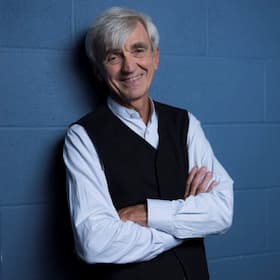
Paul Roberts © Viktor Erik Emanuel
Poetry and literature were meat and drink to Franz Liszt, who performed in and attended the cultural salons of 1830s Paris where he knew writers such as Victor Hugo and George Sand. He was familiar with the writing of Byron, Sénancour, Goethe, Dante, Petrarch and others, and his scores are littered with literary quotations which offer fascinating glimpses into the breadth of his creative imagination and what that literature meant to him. For the pianist, they provide an opportunity to “live inside his mind” and open “our imaginations to the wonder of his music”.
Perhaps the most obvious connection between Liszt and poetry is his Tre Sonetti del Petrarca – the three Petrarch Sonnets. They began life as songs which Liszt later arranged for piano solo, and included them in the Italian volume of his Années de pèlerinage. Liszt and his lover Marie d’Agoult spent two years in Italy and it was here that Liszt was exposed to the marvels of Italian Renaissance art and architecture and the poetry of Dante and Petrarch.
The poetry of Petrarch was central to Liszt’s creative imagination and in his triptych inspired by the Italian poet’s sonnets, we find an extraordinary depth of expression and emotional breadth. In the chapter ‘The Music of Desire’, Roberts explores Petrarch’s sonnets in detail and demonstrates how Liszt translates the passion of the poet into some of the finest writing for piano by Liszt, or indeed anyone else.
Perhaps because I have studied and performed these pieces myself, a study which included close reference to Petrarch’s poetry, it is here that I find Roberts’ argument most persuasive, that the pianist really needs this literary context and understanding to bring the music fully to life. He shows how Liszt responds to the ebb and flow of emotions in Petrarch’s writing, in particular in the most passionately dramatic of the three sonnets, No. 104, “Pace no trovo” (I find no peace), where the poet veers almost schizophrenically between extremes of emotion, from the depths of despair to ecstasy.
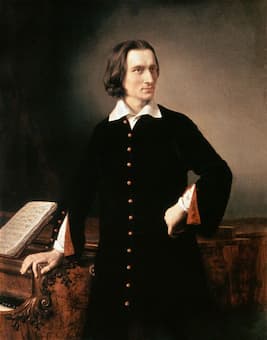
Franz Liszt
Subsequent chapters explore other great piano works – the extraordinary B-minor Sonata which Roberts believes is firmly connected to that pinnacle of nineteenth century European literature, Goethe’s Faust, the existentialism of Vallée d’Obermann, a work which exemplifies the Romantic spirit, and its relationship with Etienne de Sénancour’s cult novel Obermann, the “aura” of Byron and his Childe Harold’s Pilgrimage which pervade the Swiss volume of the Années alongside Liszt’s personal experience of the majestic landscape of Switzerland and the Alps. The final chapter explores the Dante Sonata and Liszt’s reverence for The Divine Comedy at a time when Dante’s poetry was being rediscovered by English and European Romantic writers like Keats, Coleridge, Shelley and Stendhal. Throughout, Roberts conveys the power of literature to awaken and inspire the Romantic imagination and sensibilities, and demonstrates how this might inform the way one performs Liszt’s music – from the physical cadence of poetry to its drama, narrative arc and emotional impact which had such a profound effect on Liszt and which infuses his music in almost every note. Here Liszt finds a new kind of expression in which, in his own words, music becomes “a poetic language, one that, better than poetry itself perhaps, more readily expresses everything in us that transcends the commonplace, everything that eludes analysis”.
A useful Appendix explores the influence of other poets such as Alphonse de Lamartine and Lenau, with analysis of other pianos works, including Bénédiction de Dieu dans la solitude, the Mephisto Waltz, the two St Francis legends, and Mazeppa, inspired by a poem by Victor Hugo.
In this book, Paul Roberts reveals the essence of Liszt literary world, providing the pianist with valuable insight and inspiration with which to appreciate, shape and perform his music.
Reading Franz Liszt: Revealing the Poetry behind the Piano Music is published by Amadeus Press, an imprint of Rowman & Littlefield, USA.
Musicians Divulge a Secret: The Pieces They Would Rather Not Play Ever Again!
by Janet Horvath, Interlude

Put Ravel’s Daphnis and Chloe or La Valse, Stravinsky’s Rite of Spring, or Rachmaninoff’s Symphonic Dances—or pretty much anything by Prokofiev or Mahler—in front of me and I’ll play them happily over and over, and I have. But dear readers I must confess there are pieces of music I hope I never have to play again, and I’m not alone. Some works we professionals play to death; others just get under our skin. Let me explain.
Perhaps you love the Pachelbel Canon. It’s a popular piece for weddings. While the violins soar through multiple variations the poor cellist plays the same 8 notes s-l-o-w-l-y, repeating the pattern D-A-B-F#-G-D-G-A. Each iteration takes 4 measures and is played 28 times! And some perform it extra deliberately. It’s a bit like detention for cellists! Funny enough, once a local National Public Radio classical music radio station played this continuously until they’d met their pledge drive donation goals. I imagine some listeners silently (or loudly) screamed, “Make it stop…”

Crazy instructions!
Ravel’s Bolero is another very popular piece of music but not for the snare drum player. He or she has to play the two-bar 24-note pattern unrelentingly steady in rhythm starting very softly or pianissimo and increasing in volume to a dramatic fortissimo. The piece is 430 bars; about 15 minutes. Need I do the math? That’s 5,144 snare drum strokes. Talk about repetition… And since we’re counting, did you know Tchaikovsky was fond of the cymbals? During Swan Lake, there are a total of 1,214 cymbal crashes in each performance. One of my colleagues sat very close to the percussion section. The din after 21 performances and 29,715 cymbal crashes, left her shell-shocked.
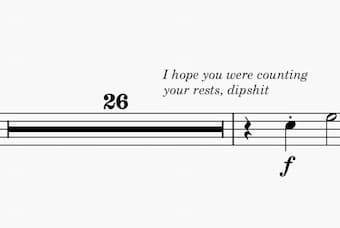 Other pieces can be tiresome because of the ubiquitous numbers of performances of them. One colleague told me, “I had a nightmare that I was playing Messiah, and I woke up and it was true!” Ditto Tchaikovsky Nutcracker. I remember during the Holidays the Minnesota Orchestra would be divided in two. Half played 10 Messiah performances and the other half performed The Nutcracker Ballet 13 times in two weeks—twice on weekend days—every season for years. May I remind you of the temperatures in December in Minnesota that dip well below zero? The nearest parking was several blocks away. I’d drag my cello in the bitter cold to the huge auditorium hoping to thaw in time for the performances.
Other pieces can be tiresome because of the ubiquitous numbers of performances of them. One colleague told me, “I had a nightmare that I was playing Messiah, and I woke up and it was true!” Ditto Tchaikovsky Nutcracker. I remember during the Holidays the Minnesota Orchestra would be divided in two. Half played 10 Messiah performances and the other half performed The Nutcracker Ballet 13 times in two weeks—twice on weekend days—every season for years. May I remind you of the temperatures in December in Minnesota that dip well below zero? The nearest parking was several blocks away. I’d drag my cello in the bitter cold to the huge auditorium hoping to thaw in time for the performances.
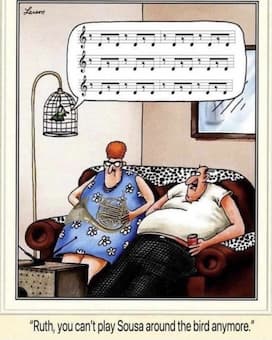 There are many works that are ever-present in our repertoire. Sometimes the consequences of often-played repertoire are that they are given short shrift in rehearsal. No musician enjoys walking on eggshells during a concert or conversely slamming through a work such as Liszt Les Preludes, Orff’s Carmina Burana, Tchaikovsky’s Romeo and Juliet or the Symphonies No. 4 or No. 5, or even Handel’s Water Music. There are always tricky passages and difficult transitions that should be rehearsed for ensemble.
There are many works that are ever-present in our repertoire. Sometimes the consequences of often-played repertoire are that they are given short shrift in rehearsal. No musician enjoys walking on eggshells during a concert or conversely slamming through a work such as Liszt Les Preludes, Orff’s Carmina Burana, Tchaikovsky’s Romeo and Juliet or the Symphonies No. 4 or No. 5, or even Handel’s Water Music. There are always tricky passages and difficult transitions that should be rehearsed for ensemble.
Perhaps a particular piece brings back bad memories. Did your mom force you to play Für Elise by Beethoven or Haydn Trumpet Concerto for Aunt Betsy, and Grandma Rose and every person who was invited over for dinner when you were growing up no matter how you protested? My parents were guilty.
Please don’t blame the poor second violins and violas (and sometimes the horns) when they almost drop their instruments in boredom. While you’re elegantly waltzing, they have to play endless off beats in Strauss waltzes or Sousa Marches, and they rarely get to play the melody.
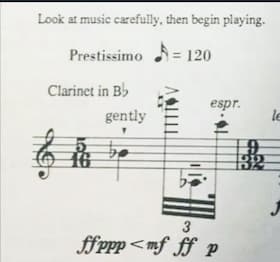
Unplayable!
We really have no patience for a composer who doesn’t know our instrument and writes nothing but rests. We relish performing pieces that are challenging unless the composer’s metronome markings suggest an unplayable tempo, contradictory (or silly) instructions, or if he or she uses an undecipherable meter, like something you’ve seen in a calculus textbook watch out. That’s when we might throw up our hands!
Even soloists must bemoan the fact that certain concertos, favorites and crowd-pleasers, are requested in every city despite the fact that an artist hopes to perform more unfamiliar works worth playing and hearing. But that said, we never tire of the great masterworks: Brahms, Sibelius, Barber, and Mendelssohn Violin Concertos, Brahms, Schumann, Grieg, Rachmaninoff, Prokofiev, and Tchaikovsky Piano Concertos and Beethoven of course.
Pianist Jon Kimura Parker tells us that he first played the Beethoven Third Piano Concerto in C minor, when he was twelve years old. It was his concerto debut in Vancouver, with the Vancouver Symphony and the first concerto he ever learned. This week, the 50th anniversary of performing the work, he still finds new revelations, after playing it countless times. Beethoven’s vehement music continues to speak to us. Surely music wouldn’t be where it is today without him. Listen to this rendition of the last movement of Beethoven’s First Piano Concerto during Covid. “One can only imagine what Beethoven would think of all of this,” says Parker. “That his music is being performed so much even now, when our logistic preparations have required extra imagination, would surely boggle his mind!”
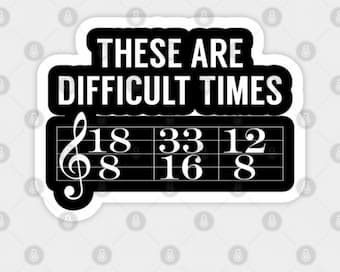 Rather than predictable as some music is, this music never ceases to amaze performers and listeners alike. But even the masterworks of our repertoire benefit from a fresh approach by the artist and/or new ideas from the conductor.
Rather than predictable as some music is, this music never ceases to amaze performers and listeners alike. But even the masterworks of our repertoire benefit from a fresh approach by the artist and/or new ideas from the conductor.
My suggestion for programing a recital, a small ensemble concert, or a full orchestra season: it would be wise for small ensemble artistic directors, orchestra managements, and conductors to consider not only “good box office” but also what will challenge, inspire, and stimulate the musicians. That’s no secret!
Thursday, August 11, 2022
Love is in the Air - Gimnazija Kranj Symphony Orchestra
245,836 views Jan 13, 2013 Gimnazija Kranj Great Spring Concert 2012 in Gallus Hall, Cankarjev dom. 20.th concert aniversary. Music, Rhytm and Dance. 10 years of Gimnazija Kranj Symphony Orchestra. Also celebration of 20th year of our lead sponsor: Hranilnica Lon bank. They performed disco legend: Love is in the Air. Arrangement: Nejc Bečan. Sold out concert and amazing performance.
Sponsor: Hranilnica Lon d.d., Kranj. Conductor: Nejc Bečan; concert direction: Primož Zevnik; glasba:
The 110-year-old Titanic violin that miraculously survived the sinking ship
By Siena Linton, ClassicFM
This violin holds a lifetime of stories in the grain of its wood...
Of all the instruments in the world, violins and other string instruments are often renowned for their longevity, with the centuries-old creations of Italian luthiers, Amati and Stradivari, holding hundreds of years’ worth of stories, and selling for millions of pounds today.
Few, however, can compete with that of the Titanic violin – the instrument played in April 1912, as the RMS Titanic sank into the North Atlantic Ocean after its fatal collision with an iceberg.
Today, the violin is held at the Titanic Museum in Tennessee, as part of their public display of artefacts and memorabilia from the ship.
But the story of how it got there is not quite so simple...
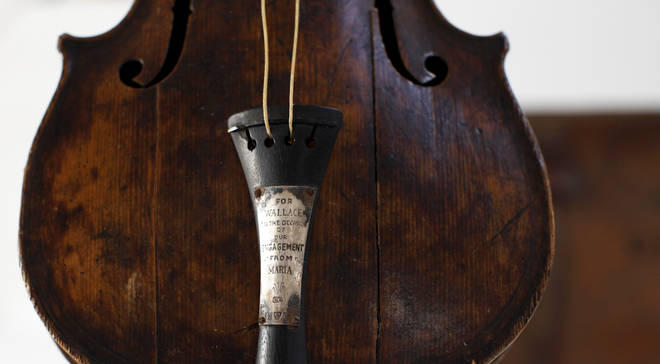
A wedding that never took place
The now-famous violin was crafted in Germany in 1910, and was gifted to Wallace Hartley of Colne, Lancashire, as an engagement present from his new fiancée Maria Robinson. An inscription on the instrument’s tailpiece read, ‘For Wallace, on the occasion of our engagement, from Maria’.
The sweethearts likely met in Leeds, where Hartley played as a musician in various institutions around the city. Having previously provided musical entertainment on the RMS Mauretania, Hartley was contacted shortly before the RMS Titanic departed from Southampton on its maiden voyage with a request that he become its bandleader.
After his initial reluctance at leaving his fiancée, Hartley agreed to join the transatlantic crossing, hoping to secure future work with some new contacts before returning for his June wedding.
Tragically, the wedding never took place. Four days into the crossing, the Titanic hit an iceberg in the North Atlantic ocean, and sank on the 15 April 1912, taking more than 1,500 passengers and crew members with it – Hartley included.
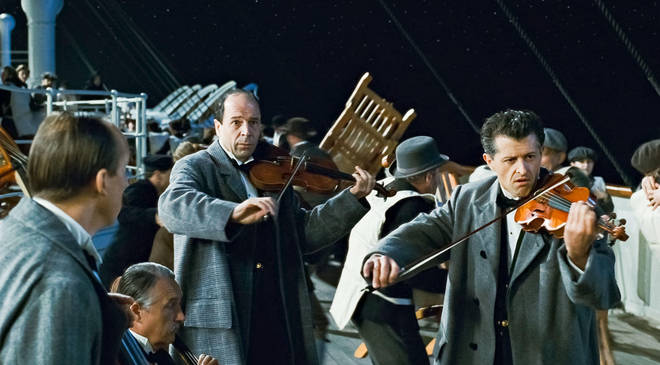
‘Gentlemen, it has been a privilege playing with you tonight’
In a depiction made famous by the 1997 film Titanic (see above), the eight musicians on board the ship continued to play amid the havoc, as women, children and first-class passengers were loaded hurriedly onto lifeboats.
At maximum capacity, the lifeboats barely had space for half the people on the ship, and as the wooden boats began to depart with seats still vacant, it soon became clear that many of those still on board the rapidly sinking cruise liner would not be saved.
As was his command, bandleader Wallace H. Hartley gathered his seven fellow musicians to play music in an attempt to calm the pandemonium and still people’s fears. Survivors of the ship report that the band played upbeat music, including ragtime and popular comic songs of the late 19th and early 20th century.
One of the popular myths surrounding the Titanic and its historic fate is that the band played the hymn ‘Nearer, My God, to Thee’ in their final moments. Some accounts dispute this, claiming that the musicians were last heard playing Archibald Joyce’s waltz, ‘Dream of Autumn’, before abandoning their instruments.
If the musicians were indeed playing music to the very end, it does seem likely that Hartley would have chosen the hymn as their swan song.
Hartley’s father, Albion, was the choirmaster at the Methodist chapel in the family’s hometown, and had introduced ‘Nearer, My God, to Thee’ to the congregation.
Hartley had also told a former colleague on the Mauretania that, should he ever find himself aboard a sinking ship, the hymn would be one of two pieces he would play in his final moments – a chilling foreshadowing of events to come.
Only three of the musicians’ bodies were recovered from the wreckage, including Hartley’s. A detailed inventory documents the personal effects that were found with him, including a gold fountain pen and silver match box, both engraved with his initials, and a diamond solitaire ring.
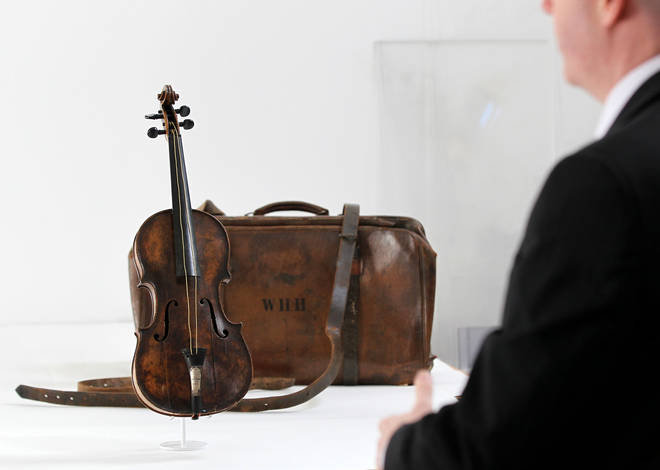
Rediscovered in an attic
Despite some reports to the contrary, there is no evidence that his violin was found strapped to his chest in its case. We do know, however, that it must have been recovered, along with a satchel embossed with Hartley’s initials, as a telegram transcript from Maria Robinson to the Provincial Secretary of Nova Scotia reads, ‘I would be most grateful if you could convey my heartfelt thanks to all who have made possible the return of my late fiancé’s violin’.
When Robinson died in 1939, her sister gave the violin to the Bridlington Salvation Army, who passed it on to a violin teacher. The teacher passed it on further, and in 2004 it was rediscovered in an attic in the UK.
Sceptics initially refused to believe that this could be the real thing, assuming that the violin would have been so badly damaged by water that it simply could not have survived.
However, after nine years of evidence gathering and forensic analysis, including CT scans and a certification by the Gemological Association of Great Britain, it was confirmed that this was, in fact, the violin that Wallace Hartley had played aboard the RMS Titanic.
Forensic experts certified that the engraving on the metal tailpiece was “contemporary with those made in 1910”, and that the instrument’s “corrosion deposits were considered compatible with immersion in sea water”.
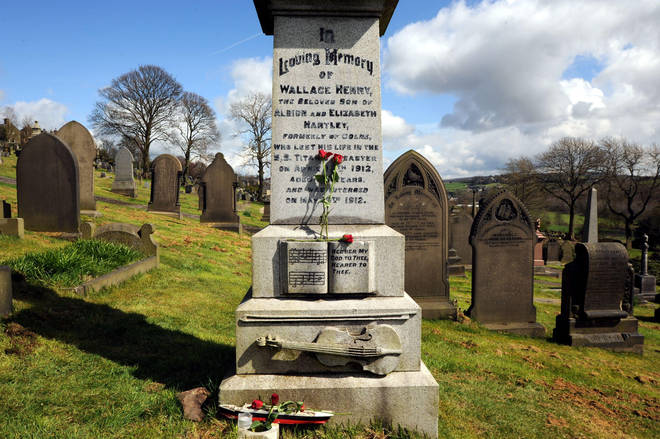
Sold for nearly a million
On 19 October 2013, the violin was sold at auction by Henry Aldridge & Son in Wiltshire for £900,000 (equivalent to over £1,000,000 in 2022), a record figure for Titanic memorabilia. The previous record was thought to have been £220,000 paid in 2011 for a plan of the ship that had been used to inform the inquiry into the ship’s sinking.
The violin is irreparably damaged and deemed unplayable, with two large cracks caused by water damage and only two remaining strings. Its current owners are unknown, but believed to be British.
As for Hartley, he was buried in his hometown of Colne in Lancashire, at a funeral service that was attended by over 20,000 people, and included the hymn that will forever be associated with him, ‘Nearer, My God, to Thee’.
The headstone of his final resting place includes an inscription of the hymn’s opening notes, above a violin carved out of stone.
Tuesday, August 9, 2022
24 Amazing Facts About JS Bach
Published by Revelle Team on June 10, 2016
Baroque and Bach are two words that are very often linked together. Widely regarded as one of the definitive composers of the Baroque period, Johann Sebastian Bach’s works are still loved today as each new generation discovers his incredible gift.
However, many people are unaware that without some specific enthusiasm and recognition for this master’s classical works, Bach might have been relegated to obscurity. Only having been known as a skilled organist, musical mathematician, and that guy with the perfectly curled, white wig.
Fortunately however, his musical compositions were admired and appreciated by geniuses like of Mozart and Beethoven; and in 1829, nearly 60 years after his death, Felix Mendelssohn, carried Bach’s Passion According to St. Matthew out of oblivion and into the German concert hall for a significant historical event. Although it had been nearly a hundred years after this beautiful masterpiece had been composed, the concert ignited a flame of curiosity and re-evaluation of Bach’s work, resulting in a world-wide acknowledgement of his brilliance and importance to Baroque classical music.
Here are 24 additional facts and trivia about this famous composer:
Johann Sebastian Bach was born March 31, 1685 in Eisenach, Thuringia, Germany.
His father, Johann Ambrosius Bach was a 7th generation musician, and carried on the tradition by teaching him how to play the violin.
Bach lost both his parents when he was 10 years old. While living in Ohrdruf, Germany, his older brother Johann Christoph Bach taught him organ.
In 1700, he was granted a scholarship at St. Michael’s School in Luneburg for his fine voice.
During an inaugural recital on the new organ his talents earned him the job of organist in Arnstadt, in 1703, at New Church, where he provided music for the services at the church, as well as instruction in music to the local children.
Bach moved to Muhlhausen in 1707 to become the organist in the Church of St. Blaise.
Bach married his cousin, Maria Barbara Bach, and they had seven children. His sons Wilhelm Friedemann and Carl Philipp Emanuel became composers and musicians like their father.
Bach’s next position was as court organist in Weimer, in 1708 for Duke Wilhelm Ernst. It was here he composed his very famous Toccata in D Minor.
Bach was given a diamond ring in 1714 from the Crown Prince Fredrick of Sweden who was amazed at his playing.
Having angered Duke Wilhelm for requesting release from his position on short notice and desiring to go work for Prince Leopold of Koethen, Bach was arrested and put in jail for several weeks in 1716.
Upon his release from jail, Bach became the conductor of the court orchestra, in which Prince Leopold played.
In 1719, Bach tried to arrange a meeting with another prolific composer of that era, George Frideric Handel. Despite being only 130 kilometers apart, the two never did meet.
Bach’s wife, Maria, died suddenly in 1720 while he was away with Prince Leopold. She was 35 years old. The fifth and final movement of the Partita in D Minor for solo violin, “Chaconne,” was written to commemorate her.
In 1721, Bach married Anna Magdalena Wülcken. They had thirteen children.
Bach wrote the majority of his instrumental works during the Koethen period.
In 1723, he became the choir leader for two churches in Leipzig, Germany, in addition to teaching music classes and giving private lessons.
Most of Bach’s choral music was composed in Leipzig.
Bach’s deep religious faith could be found even in his secular music. He would put the initials “I.N.J.,” a Latin abbreviation that means, In Nomine Jesu, or “in the name of Jesus,”on his manuscripts.
The Brandenburg Concertos were written in 1721 as a tribute to the Duke of Brandenburg.
The Well-Tempered Clavier was composed as a collection of keyboard pieces to help students learn various keyboard techniques and methods.
Fredrick the Great, King of Prussia inspired Bach’s composition of a set of fugues called Musical Offering in 1740.
The Art of Fugue was begun in 1749 but was not completed.
After struggling with blindness and a failed surgery on his eyesight, Bach suffered a stroke and died in Leipzig, July 28, 1750. He was 65 years old.
His entire career was spent in a contracted area of Germany that is smaller than most of the States in America.
Johann Sebastian Bach is considered the quintessential composer of the Baroque era, and one of the most important figures in classical music in general. His complex musical style was nearly lost in history but gratefully it survives to be studied and enjoyed today. You can learn more about this icon by visiting his dedicated website. In the words of Johannes Brahms (1833-1897), “Study Bach: there you will find everything.”
30 Inspirational Quotes For Every Musician
Published by StringOvation Team on February 09, 2017
Most of us, from time to time feel discouraged. In fact, because we all need emotional boosts every once in a while, a large portion of social media content is motivational, designed to uplift your soul and the souls of others. So, in the spirit of time-honored encouragement, the following quotes are specifically for musicians. If you’ve been feeling down about your progress as a musician or just about where your talent might take you, the musings of these various composers and performers should help elevate your psyche.
The following inspirational quotes for musicians were gleaned from a variety of sources, including BrainyQuotes, Musicians Buy Line, Classic FM, and Quotes-Inspirational. They feature insights from musicians of all genres and levels of success, as well as a few from composers, philosophers, and other iconic thinkers.
Igor Stravinsky: "Lesser artists borrow, great artists steal."
J.S. Bach: "I was obliged to be industrious. Whoever is equally industrious will succeed equally well."
Robert Schumann: "To send light into the darkness of men's hearts - such is the duty of the artist."
Dmitri Shostakovich: "A creative artist works on his next composition because he was not satisfied with his previous one."
Elvis Presley: “The truth is like the sun. You can shut it out for a time, but it ain't goin' away.”
Mick Jagger: “Lose your dreams and you might lose your mind.”
BB King: “The beautiful thing about learning is that nobody can take it away from you.”
Bob Marley: “One good thing about music, when it hits you, you feel no pain."
Pablo Casals: “Music is the divine way to tell beautiful, poetic things to the heart."
Billy Joel: “I think music in itself is healing. It's an explosive expression of humanity. It's something we are all touched by. No matter what culture we're from, everyone loves music."
John Lennon: “Life is what happens when you’re making other plans.”
Marcus Miller: “It's a great thing about being a musician; you don't stop until the day you die, you can improve. So it's a wonderful thing to do."
Thelonious Monk: “All musicians are potential band leaders.”
Sting: “If you play music with passion and love and honesty, then it will nourish your soul, heal your wounds and make your life worth living. Music is its own reward.”
Ludwig van Beethoven: “Music is a higher revelation than all wisdom and philosophy. Music is the electrical soil in which the spirit lives, thinks and invents.”
Bono (U2): “Music can change the world because it can change people.”
Carlos Santana: “Just as Jesus created wine from water, we humans are capable of transmuting emotion into music.”
John Denver: “Music does bring people together. It allows us to experience the same emotions. People everywhere are the same in heart and spirit. No matter what language we speak, what color we are, the form of our politics or the expression of our love and our faith, music proves: We are the same.”
Plato: “Music is the movement of sound to reach the soul for the education of its virtue.”
Thomas Carlyle: “Music is well said to be the speech of angels.”
Roy Ayers: “The true beauty of music is that it connects people. It carries a message, and we, the musicians, are the messengers.”
William Congreve: “Music hath charms to soothe the savage beast, to soften rocks or bend a knotted oak.”
Oliver Wendell Holmes: “Take a music bath once or twice a week for a few seasons, and you will find that it is to the soul what the water bath is to the body.”
Chris S. Salazar: “Music is by far the most wonderful method we have to remind us each day of the power of personal accomplishment.”
Karlheinz Stockhausen: “Whenever I felt happy about having discovered something, the first encounter, not only with the public, with other musicians, with specialists, etc, was that they rejected it.”
John McLaughlin: “At the risk of sounding hopelessly romantic, love is the key element. I really love to play with different musicians who come from different cultural backgrounds.”
Billy Joel: “Musicians want to be the loud voice for so many quiet hearts.”
Neil Diamond: “Because my musical training has been limited, I've never been restricted by what technical musicians might call a song.”
Igor Stravinsky: “Too many pieces of music finish too long after the end.”
Plato: “Music gives a soul to the universe, wings to the mind, flight to the imagination, and life to everything.”
You may have already heard some of these inspirational quotes for musicians, but it never hurts to hear them again.
Subscribe to:
Comments (Atom)


